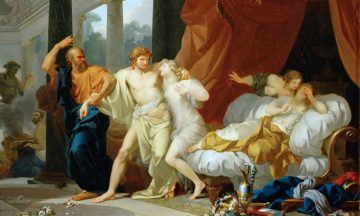Arman D’Angour in Aeon:
 Sources from late antiquity, such as the 5th-century CE Christian writers Theodoret of Cyrrhus and Cyril of Alexandria, state that Socrates was, at least as a younger man, a lover of both sexes. They corroborate occasional glimpses of an earthy Socrates in Plato’s own writings, such as in the dialogue Charmides where Socrates claims to be intensely aroused by the sight of a young man’s bare chest. However, the only partner of Socrates’ whom Plato names is Xanthippe; but since she was carrying a baby in her arms when Socrates was aged 70, it is unlikely they met more than a decade or so earlier, when Socrates was already in his 50s. Plato’s failure to mention the earlier aristocratic wife Myrto might be an attempt to minimise any perception that Socrates came from a relatively wealthy background with connections to high-ranking members of his community; it was largely because Socrates was believed to be associated with the antidemocratic aristocrats who took power in Athens that he was put on trial and executed in 399 BCE.
Sources from late antiquity, such as the 5th-century CE Christian writers Theodoret of Cyrrhus and Cyril of Alexandria, state that Socrates was, at least as a younger man, a lover of both sexes. They corroborate occasional glimpses of an earthy Socrates in Plato’s own writings, such as in the dialogue Charmides where Socrates claims to be intensely aroused by the sight of a young man’s bare chest. However, the only partner of Socrates’ whom Plato names is Xanthippe; but since she was carrying a baby in her arms when Socrates was aged 70, it is unlikely they met more than a decade or so earlier, when Socrates was already in his 50s. Plato’s failure to mention the earlier aristocratic wife Myrto might be an attempt to minimise any perception that Socrates came from a relatively wealthy background with connections to high-ranking members of his community; it was largely because Socrates was believed to be associated with the antidemocratic aristocrats who took power in Athens that he was put on trial and executed in 399 BCE.
Aristotle’s testimony, therefore, is a valuable reminder that the picture of Socrates bequeathed by Plato should not be accepted uncritically. Above all, if Socrates at some point in his early manhood became the companion of Aspasia – a woman famous as an instructor of eloquence and relationship counsellor – it potentially changes our understanding not only of Socrates’ early life, but of the formation of his philosophical ideas. He is famous for saying: ‘All I know is that I know nothing.’ But the one thing he claims, in Plato’s Symposium, that he does know about, is love, which he learned about from a clever woman. Might that woman have been Aspasia, once his beloved companion? The real Socrates must remain elusive but, in the statements of Aristotle, Aristoxenus and Clearchus of Soli, we get intriguing glimpses of a different Socrates from the one portrayed so eloquently in Plato’s writings.
More here.
